Archive for Landscape Design
7 Reasons Property Owners Rely on Garden Professionals
Using a professional landscape maintenance company is a no-brainer for anyone who doesn’t enjoy yard work but wants their landscape to look its very best.
However, even avid gardeners and those who enjoy working outside find using a professional gardening service makes their life easier and enhances their efforts.
Here are seven reasons why hiring a garden service makes sense – no matter how much you enjoy working outside.
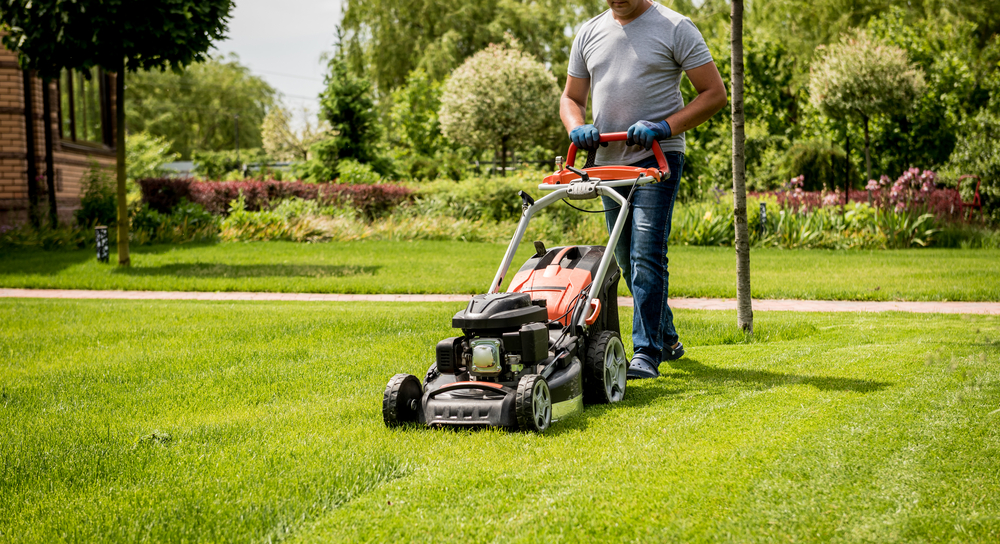
1. Increase year-round interest & curb appeal
Along with the regular yard maintenance routine, garden services include little extras that increase year-round interest and curb appeal. For example, we work with clients to:
- Ensure there’s color and interest during all four seasons.
- Hone in on the trees, shrubs, flowering plants, and grasses that make sense for their property’s microclimate.
- Expand their knowledge of native and non-native landscape options to keep things fresh and interesting.
- Take over the chores they don’t want to do themselves so they can focus on the tasks they enjoy most.
- Learn techniques, tips, or tricks to expand existing knowledge and expertise.
We always enjoy caring for yards and landscapes, but we’re especially inspired by homeowners who love to grow and nurture their landscapes as much as we do.
2. They work in more adverse weather conditions than the average gardener
Sure, working outside is wonderful – all that fresh air and sunshine does a body good. But what about the days that are hotter or cooler than you’d like them to be? Or the days when you feel under the weather yourself?
Your professional landscape maintenance team is there for you (almost) regardless of the weather, so you can stay comfortably tucked inside without worrying about whether the lawns are mowed or the shrubs are pruned.
3. We’re never in over our heads
Just as a foodie’s eyes may be bigger than their stomach, a garden lover’s eyes may be bigger than their available calendar days. A lush, beautiful landscape requires continuous work.
Sometimes that work is a little effort daily or weekly; other times, it requires a significant amount of labor day in and day out.
Garden and landscape professionals do this for a living, so our calendar is integrated with your landscape’s needs. In addition, we’re happy to take on extra tasks when you can’t get around to it, which means you never have to feel guilty about all of the yard work or gardening that isn’t being done – or about the new garden projects you never have time to bring to fruition.
4. You can enjoy cut flowers from your garden
Growing and maintaining a cut flower garden takes a tremendous amount of time, but the results are worth it when you see beautiful bases filled with blooms on your dining/end tables or other prominent surfaces.
Your professional garden crew can work with you to plant and cultivate your favorite flowers or blooms and foliage in your favorite hues. You’ll have beautiful blooms to cut and display whenever you want.
5. Maintain safe and attractive hardscape features
Over time, walkways crack or become uneven. The lighting features may have burned-out bulbs or electrical issues. Water features can plug or wear out, and the fire pit or planter surrounds may need updating. By scheduling weekly or bi-monthly garden service, you can rest assured the entire landscape – including its hardscape features – will be tended to regularly.
Some routine maintenance issues happen automatically, like simple leak repairs or bulb replacements. If and when more significant repairs or renovations are needed, we’ll let you know, provide an estimate and can schedule or perform that work for you.
6. We can redesign or expand your existing landscape
Are you ready to design a new area of your landscape? Is it time to rip out an area of non-native plants and replace them with a more water-wise xeriscape? Would you like to cultivate a garden that attracts more birds and pollinators – or repels the local deer?
All of that is possible when you use a professional garden service. We love working with clients who are inspired to continue the evolution of their landscape and garden environments. We are always there to provide insight, advice, and labor to ensure your landscape spaces serve your household’s current needs – whether that be a kid-safe space to play or an area that can handle the wear and tear of the beloved four-legged members of the family.
7. No need to have a single tool
Professional garden services bring all of the tools and equipment required for the job. That means you don’t have to own or maintain a single tool or garden-specific machine. There’s no need to purchase or store fertilizers or other amendments that keep gardens looking their best. We take care of all that for you, freeing up your garage and storage spaces.
Contact Us To Learn More About Professional Garden Service Options
We tailor garden services to meet customers where they’re at. Contact us to learn more about our service offerings and how we can keep your landscape lush and vibrant all year round.
4 Basic Principles of Garden Design
To get the most out of your garden design, you need to know some basic principles of landscaping. By paying attention to the principles, you’ll increase your creativity and generate new ideas for a unique effect. The best thing is that these guidelines are neither fussy nor constraining. If you have an eye for detail, you’ll quickly end up with a more successful and eye-catching California garden design.
1. Generous Use of Color
Color brings the dimension of life to your garden design. Warm colors like red, orange, and yellow tend to bring objects closer to you. Cool colors like blues and greens are effective in moving things away from you.
A balanced combination of both warm and cool colors can help create perspective in your design. They work well for both plants and hardscape to bring out a particular mood. In garden design, weave colors intricately throughout the design composition for a more balanced look. Remember to extend the presence of color across the seasons at various levels.
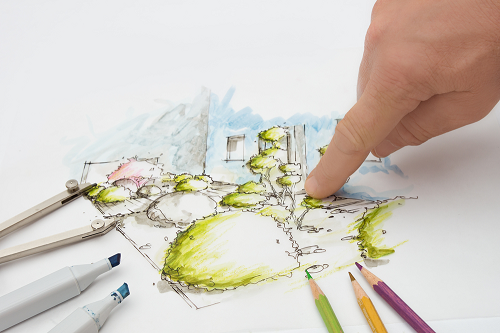
2. Lines are Important in Garden Design
The concept of regulating lines is essential in garden design. An architecture element, like a building edge or door, can create an imaginary line to help connect and organize your layout. They are essential in helping you control movement, accentuate an object, or draw attention to a focal point.
For example, a garden path or walkway leading to an area of interest will naturally direct a person to that object. On the contrary, a meandering walkway will create a feeling of uncertainty or surprise.
Lines can be vertical, diagonal, curved, or straight and may either be real or implied. The latter is created from a series of objects aligned in a way that makes them look like they are in a line. This effect is common in designs that use plant forms to imply a line. The use of lines to regulate the garden design spells the difference between professional and amateur design.
3. Bring Out Texture in Your Design
In gardening, the use of texture is common to achieve a fantastic curb appeal. Texture falls into three different categories, namely, fine, medium, and coarse. For example, the texture of pavements differs from that of plants and other elements. Contrasting textures can add an exciting feature to design composition.
The texture of plants in gardening refers to the overall presence of the plants. In general, plants have two texture types, namely, bold and soft. Bold textures tend to attract more attention. They are those plants that reach great heights and come with large, impressive foliage.
Plants with soft textures have a less visual impact as they have small and delicate foliage. They may not make a statement in the garden immediately, but they effectively offer a whimsical appearance, serving as a vital aspect of the garden.
4. Unity in Your Overall Design
The three principles above are not complete without unity. In this case, unity refers to the repetition, balance, harmony, and consistency of a design. Consider repeating elements like plants, color, and decor in the landscape. Consistency is crucial as it helps you achieve unity by bringing together different landscaping elements to create a common theme.
Don’t forget to balance your design, either symmetrically or asymmetrically. In symmetrical balance, two sides of your design look similar, while asymmetrical balance is more about using different objects and elements to achieve balance. They, however, must have almost identical imaginary weight, size, and shape.
Final Thoughts
With these four principles of garden design, you can creatively unleash your landscaping prowess. Utilizing color combinations, lines, and textures, you will end up with a unified design of your landscape. If you need professional help in your garden design venture, reach out to us for expert guidance.
8 Essential Lawn Treatments for a Healthy Lawn
A healthy and vibrant lawn does not just happen. It takes a lot of care and treating it the right way. You can get a lush yard by using the best lawn treatment practices. Time your treatment procedures correctly to avoid damaging the turf by exposing it to weed, pests, and weather damages.
Although each lawn is unique, there are common lawn care practices for people wanting an evergreen, lush lawn. Here are 8 essential treatments for a healthy lawn.
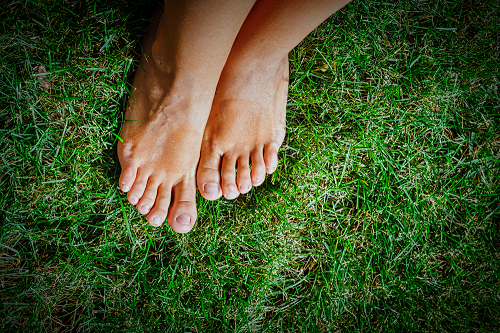
Plant Types
Find out the best plants to grow in your location. You can grow warm-season or cool-season plants- depending on your climate. The climate and plants you grow will determine the herbicides and pesticides to use. Consult with your lawn treatment specialist to help you select the ideal plants for your yard.
Mowing
The best time to mow your lawn is early in the morning or late evening when the temperatures are low. This protects your grass from going into shock.
When cutting your grass, adjust your blades to help you trim the top third of the lawn grass. This is called the one-third rule of mowing. Avoid mowing wet grass as it clogs the mower blades, causing them to transmit diseases across your yard.
Weed Control
Prevent weeds from growing in your yard to get a healthy lawn. Proactive weed control helps you stop pre-emergent weeds. Do this continually to avoid the weds from resurfacing in the next season.
You can achieve this by using targeted weed control, where your lawn treatment expert tests the soil to find out the predominant weeds and their growing seasons. This helps you use pre-emergent weed control measures to eliminate all weeds in your lawn.
Avoid toxic herbicides that may harm your grass, pets, and the environment. Study the labels on herbicides and follow the instructions, or let a lawn expert apply them for you to avoid undesirable results.
Watering
The amount of water and frequency of watering depends on the climate. If you receive enough rain, your lawn will grow well with minimal watering. Look out for signs of water shock to know when your yard needs watering.
The best test for water shock on a lawn is walking on it and observing if your footprints remain visible. If they do not, the grass has sufficient water.
Water your lawn deeply and infrequently to ensure it has enough water to support the grass to grow healthy. The yard should drain well so that the grass is watered uniformly without any parts forming water puddles that can damage your turf.
Aeration
Harsh weather conditions and heavy foot traffic may cause compacted soil ad dense thatch to form on your lawn. This blocks pathways for water, nutrients, and water, leaving the yard looking unmaintained.
If your pets spend all the time on your lawn, they may ruin it if they do not have specific urination spots. Assess the yard to note the damages you need to correct during aeration.
Aeration reduces soil compaction, water run-off, and thatch build-up. As professionals aerate your lawn, they will test the soil to determine nutrients deficiency to advise you on the best fertilizers for your turf.
Overseeding
After aeration, you should spread grass seeds over your turf to encourage new growth to replace damaged grass. This improves the overall appearance and health of your lawn. It also ensures there are no bare spots on the turf.
A thick turf leaves no room for weeds to grow. It is also easier to control pests on a thick turf since they don’t have spaces to hide in.
Fertilization
The right kind of fertilizer and accurate application timing is essential for a healthy, vibrant lawn. Ensure the fertilizer is appropriate for the issues your yard is experiencing, such as bare spots, dry conditions, or nutrients depletion. Read the labels on your fertilizers to know the amount you need for your lawn and the right season to apply it.
Pest Control
Pests on your lawn are dangerous to people and plants. Assess your yard to know the existing pests to control them effectively. Some common pests include fire ants and grubs that cause extensive damage to lawns when they burrow the soil and feed on plant roots.
Some pesticides are harmful to humans and pets. Examine the labels on the containers to know how to handle them. You may also apply them when you expect minimal activities in the yard, such as overnight or when away. You can also use organic pesticides to minimize their effects on the environment.
Soil Amendment
Most lawns grow well if the soil has a pH level of 5.5 to 6.5. Too much acidity damages roots, preventing them from absorbing nutrients.
Soil amendment helps you balance the pH level to suit the type of grass on your lawn. Call a lawn treatment expert to test the soil and advice you on the best way to balance the soil pH level.
3 Simple Flower Bed Ideas to Reduce Maintenance Costs
Adding a flower bed to your front or back yard is a smart and quick way to add color and liven things up. However, flower beds require a lot of maintenance and upkeep after the garden is installed. Here are a few tips to add some personality to your lawn and reduce the maintenance costs.
- Design the Perfect Shape for your Flower Bed

Beauty is in the eye of the beholder. Once you’ve decided on where to plant your new flower bed, the next step is to figure out what shape you’d like to have. There are tons of forms you can choose from. However, a bed with sharp angles can be challenging to cut and maintain because it’ll be hard to cut with a lawnmower. Granted, you can tackle those angles with a weed whacker, but that will be additional work on your end. Avoid extra work by designing and constructing flower bed ideas that have gradual and smooth curves.
- Install Weed Prevention Measures
The most common weed prevention method is landscape fabric. The fabric restricts weeds from growing through. However, weed roots can grow down through the material if the weed seeds germinate above the landscape fabric layer. Adding an extra layer of mulch will provide a strong defense against weeds and keep your flower beds healthy. A practical flower bed idea is laying down the fabric before planting and making X pattern slits where you want to plant your flowers. This simple method will keep the weeds at bay.
- Select the Overall Theme
There are two types of flower bed ideas, namely:
Formal flower beds – Here, the flowers are usually limited to a few different types. These beds typically have more geometric shapes and straight lines. They often include shrubs and yews that are planted in straight lines to form a border and create designs.
Informal flower beds – Here, you’ll find many different sizes, textures, and colors of flowers. These flower beds have some structure to the design, but the lines and borders are not as defined. The plants and flowers are left to grow as they wish with a little pruning here and there to promote new growth and maintain their size.
Flower beds are mostly used as beautiful masterpieces on the lawns of many homes. However, maintaining a flower bed can be time consuming and exhausting. Contact lawn and bed experts to receive a comprehensive range of lawn care and landscaping needs tailor-made for your flower bed ideas.
Xeriscape Landscaping Ideas
Xeriscape landscape design is a garden-style that is not only environmentally friendly but also attractive. Yards that can handle xeriscape landscaping ideas feature all types of plants and garden styles. Xeriscape principles make the most of natural-occurring water.
Top Xeriscape Design Ideas
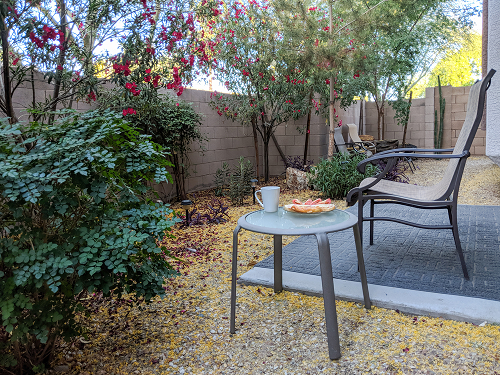
There are a few reasons homeowners develop an interest in xeriscape designs. The most common include:
- It saves money on water
- It is more eco-friendly
- It requires little maintenance
These perspectives have an impact on the decisions made during the design process. For instance, if you are approaching xeriscaping from an environment-conscious angle, you want to select native plants. For a rental home, choose low-water plants. Here are things to consider in your xeriscape landscaping ideas.
Watch Out for Problem Areas
Survey your landscape and take note of areas that appear to be problematic in terms of difficulty to water and maintain. Pay attention, especially to steep slopes, narrow strips, and corners of your lawn, drought-prone, and rocky areas. For the stubborn areas, drip irrigation may be your best choice because it applies water slowly over more extended periods to minimize the possibility of a runoff.
Choose the Right Plants
A good design for xeriscape accommodates both drought-tolerant and native plants. These should be planted according to their watering needs. Grouping plants allows you to water what needs to be watered. Soaker hoses are an ideal watering choice because they allow water to soak into the ground instead of running off.
Transform your Landscape
Begin by improving the soil. Clay soil binds together after it rains because it has small particles. This enables the soil to form a tight bond to prevent moisture from absorbing into the ground. Ensure that your soil is rich in organic matter that acts as a sponge to hold water and release moisture.
The other idea would be to use mulch. A thick layer of mulch helps in maintaining a consistent amount of soil moisture. Pine needles, grass clippings, compost, and leaves, are some of the organic mulches to use. These minimize evaporation. Some gardeners also prefer stone and gravel, but these do not decompose and can make it challenging to move plants around.
Many xeriscape landscaping ideas can be embraced without limiting you to specific types of plants. These types of gardens can be designed in many styles. You only need to select the style that suits your landscape. If you choose the right plants and exercise xeriscape principles, you will achieve a thriving and head-turning garden. We specialize in maintenance, repair, irrigation, and water-saving landscape designs. If you are looking for a professional landscaping company, please contact us today.
What Homeowners Need to Know About Hardscaping
In every home, the landscape is usually the focal point. A good landscape incorporates both greeneries and elements that add structure and functionality to a home. Gone are days when softscape was the main focus in landscaping. In fact, according to the National Association of Realtors (NAR) report, investing in outdoor hardscape projects adds resale value to a home and fulfills the homeowners.
While a well-finished hardscape sets a home apart, it is a critical landscaping aspect that most homeowners overlook. To most people, hardscape is a luxury item hence the reluctance to commit to it. But a little hardscape can go a long way. As you plan to create the ideal landscape for your home, sufficient knowledge of complex elements can help you utilize your outdoor space effectively while striking a balance between landscape elements. Here is an in-depth look at the hardscape.
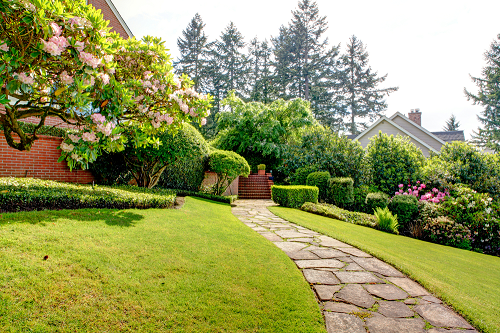
What is Hardscape?
Experts in landscape design frequently use the terms hardscape and softscape to distinguish between living and non-living elements of landscaping. Hardscape is any fixed and solid structure in an outdoor space. They include fire pits, fountains, driveways, and more. It can either be a functional or decorative structure in your landscape. Conversely, softscape pertains moveable, green exterior detailing of a home. The landscape is the umbrella term for both hardscape and softscape.
Why Hardscaping Should be Part of your home Landscape Design
Hardscape benefits are almost endless, from increasing curb appeal to adding personality to your outdoor space. Here are some of the benefits you can enjoy from incorporating hardscape into your landscape design plan.
- Hardscaping allows you to create focal points
- Low maintenance
- Water-efficient
- Increase property value
- Add dimension
- Reduce erosion
- Add privacy
Types of Hardscapes
Landscapers use various products and materials to craft a hardscape design for your outdoor space. Here is an overview.
Fire pits
Nothing brings people together like an outdoor fire pit. This attractive backyard addition can serve as a gathering for evening drinks, barbeque, and late-night s’mores. However, as a homeowner, you should be fully informed about construction requirements and potential hazards before building one.
Stone pathways
When it comes to stone pathways, the possibilities are endless, from large stepping stones to smaller ones, mosaic, and pebbles; it all goes down to what appeals to you. Whether it leads to a destination or is used for aesthetic purposes, a stone pathway can add texture and visual interest to your outdoor exteriors.
Decks and Patios
Building a deck or patio increases a living space functionality and boosts property value. Decks and patios help you make the most of your outdoor space, from hosting family parties to quiet outdoor retreats.
Retaining wall
Retaining walls in landscaping are designed to withstand lateral soil pressure, preventing soil erosion in the area and water run-off. Besides providing functionality, if well integrated with your landscape plan, they can add visual interest and dimension to your home. Furthermore, retaining walls can transform the impracticable sloped area into usable outdoor space.
Gazebos and pergolas
The main difference between a pergola and a gazebo is the function of the roof. Gazebos offer total coverage from the sun, while pergolas provide partial shelter. Getting a gazebo or pergola makes complete sense if you like spending much time outdoors. They are great for offering shade, privacy, a workspace, and even a space to entertain and dine with friends.
Fountains
Outdoor fountains come in a variety of shapes and sizes. They are also made from a variety of materials. Besides their elegant look, water fountains create a relaxing ambiance while drowning out unpleasant noises. However, due to prolonged exposure to harsh elements such as sun and wind, it is no surprise that they are prone to wear and tear. Therefore, you should always choose suitable materials tough enough to withstand harsh climates. Fiberglass makes an excellent choice.
Driveways
First impressions matter. A neat driveway with some tasteful plants and functional safety light fixtures paints a picture of a happy and successful homeowner. A good driveway layout plan should consider the surrounding landscape and your home’s architectural design to enhance functionality. Since your driveway is likely to be driven on frequently, its material should be tough enough to withstand the high traffic, oil -spills, and resist tire marks.
Conclusion
A well-designed hardscape can make your outdoor space more liveable while increasing the functionality of your home. However, hardscaping is an art and is not always easy. To create a beautiful outdoor retreat that will enhance your home, always involve a landscaping expert at DK Landscaping.
While various elements go into the overall feel of your outdoor setting, our experts combine both soft elements and structures to create a perfect outdoor space for you and your loved ones.
We are a landscape company with unmatched expertise in maintenance, repair, irrigation, and water-saving irrigation designs. Our services are ideal for both residential and commercial properties. We guarantee affordable prices and long-lasting materials. Contact us today to start a conversation about your hardscaping needs.
8 Brilliant Landscape Design Ideas
Upgrading your landscape design is a great way to create an awe-inspiring outdoor space. Whether you want to boost the general beauty of your front yard or create a stunning backyard with a dining area, there are dozens of brilliant and inspiring ideas to implement. That said, here are simple but creative ways to decorate your outdoor space.
Front Yard Landscape Designs
Your front yard makes the first impression when guests visit your property. For this reason, you need to boost your curb appeal, maybe with a stunning walkway or a beautiful lawn decorated using an eco-friendly garden. Here are some welcoming front yard landscaping ideas you can draw inspiration from.
1. Colorful Window Boxes and Floral Border
One of the best ways to revitalize your front yard is to have flowering plants create a colorful border on the entryway. A combination of the pleasant floral border and the appealing window boxes makes this design even better for your front yard. That’s because you get to beautify your entryway and draw attention to the house itself.
With this landscaping idea, you can use a mixture of perennial and annual flowers like petunias and hydrangeas for a pop of color in your front yard. You can also include a few evergreen shrubs like Pieris japonica and Cherry laurel for year-round greenery. This landscape design works in both backyards and front yards.
2. Install Path Lights in Your Front Yard
Installing path lights boosts the night-time beauty of your front yard, and most of them are easy to install. The photo above features jar path lights hanging on hooks and lining a driveway. You can also hang them on fences or set them on table-like structures along pathways.
While path lights decorate your front yard entrances and walkways, spotlights are a great alternative. They beautify your outdoor space by calling attention to specific landscape features. Spotlights have a narrower beam to focus on one thing at a time in your front yard.
3. Raised Flower Bed in the Front Yard
This flower bed in front of your house will make a statement by raising the planting surface above the lawn, which grabs attention to the plants. To create even more impact, have an irregularly shaped bed. For instance, you can go for a curve that contrasts splendidly with the regular lines of the house, just like in the photo above.
4. Leverage a Lamp Post
Installing a lamp post in your front yard adds elegance and function to your home. It improves the looks of your outdoor space and curb appeal. To ensure the lamp post blends seamlessly with other features, add a flower bed beneath it.
Backyard Landscape Designs
Your backyard is an extension of what’s going on inside your house. For this reason, you want it to be a casual, colorful, and fun place to relax and enjoy nature or a mixture of modern-natural experiences. The following landscape design ideas will help you transform your backyard into your favorite outdoor space.
5. Water-Saving Backyard
While you want your backdoor to lead to an admirable beauty, a sustainable backyard helps you save resources and reduce costs. This landscape design eliminates the backyard lawn and replaces it with modern decorative styles.
For example, you can install raised planter boxes for planting herbs and vegetables. You can also have a fire pit, concrete stepping stones, and gravel in the backyard. That way, you get to save water since the landscape design reduces the number of plants in your backyard.
6. Rock Borders
Having a beautiful backyard doesn’t necessarily mean expensive garden supplies and modern decorative structures. Go to the nearest river, beach, or anywhere you can collect various rocks. Then, use them to create a perimeter between your backyard flower bed and lawn. If the color of the stones becomes a concern, you can paint them to complement the surroundings and bring out the beauty you’re looking for. This simple landscaping design creates a pleasant transition between your garden and grass.
7. Plant Flowers Along the Fence
A fenced backyard is private and safe, but it doesn’t always look attractive. Dress your fence with colorful flowers to eliminate the dullness and enliven the atmosphere. Use a border flower garden for popping color and life in your outdoor space.
Hang planters on each fence post to complement the ground garden for an even better result. That way, you’ll create a comfy place to relax and a beautiful backyard that increases the value of your property.
8. Hanging Tree Lights
If you’re looking for a magical vibe in your backyard, incorporate outdoor lights directly with nature. Tree light pendants like those in the above photo are the best way to achieve a heavenly experience in your outdoor space. You can suspend them over tree branches to set the mood for evening garden parties or dinner.
Let a Skilled and Experienced Landscape Designer Transform Your Yard Into Magnificent Beauty
As experienced professionals, we have great landscape design ideas and tools necessary to beautify your front and backyard.
We specialize in maintenance, repair, irrigation, and water-saving landscape designs.
Contact us today for more information.
Lawn Treatment Basics
Lawn Treatment Basics Maintaining a healthy lawn can be an overwhelming undertaking for anyone. You have to find and use the correct fertilizers, pesticides, and treatments to control weeds and keep bugs at bay. If left untreated, your yard can turn into an eyesore due to the brown patches and out-of-control weeds. With the help of a landscaping professional, this does not have to be the case. Here are a few lawn treatment basics that you need to know to keep your turf green and healthy throughout the year.
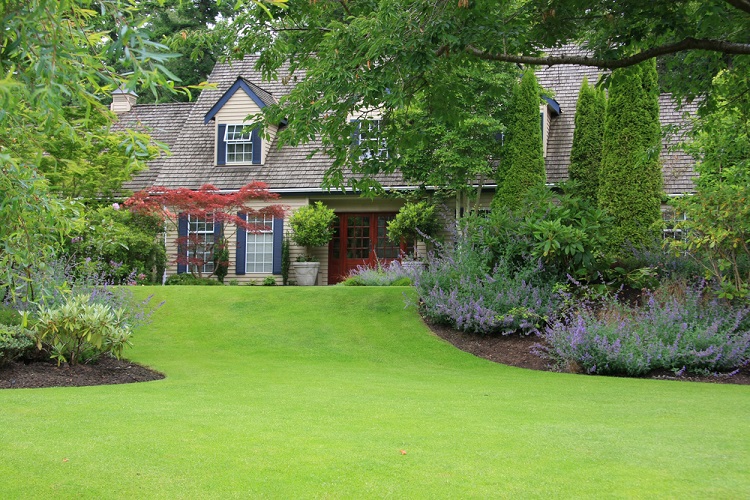
What is Lawn Treatment?
Lawn treatment refers to a series of tasks to protect your lawn from pests and weeds and ensure healthy grass growth throughout the year. It may entail spraying, fertilizing, dressing, watering, and mowing the grass to make sure it remains damage-free all year round.
As the grass on your lawn grows, it will likely attract all sorts of weeds and plant-eating pests. Pest invasions and uncontrolled growth of weeds may wreak havoc on your landscaping, leading to brown patches and stunted grass.
Applying various treatments correctly and appropriately can help save your lawn from dying and ensure it remains green and lush just the way you want it.
Types of Lawn Treatment
As you already know, lawn treatment involves several activities to help keep your grass healthy and vibrant. The four main types of lawn treatment you should know about include:
Fertilization
The soil on your lawn may not provide all the nutrients required for healthy growth. For this reason, consider adding fertilizer to your yard to help promote foliar and root growth. You have the option to use either commercial or natural fertilizer formulated for that particular season.
Make sure the fertilizer contains vital nutrients such as nitrogen for foliar growth and phosphorous for root growth. If you prefer organic fertilizers, consider using compost or natural ingredients like blood meal and meat meal.
Pest Control
Well-maintained lawns are not immune to pests and insects. No matter how healthy your lawn seems, it will still attract all sorts of bugs and insects such as beetles, sod webworms, crickets, fire ants, chafer grubs, fairy rings, and liverworts. It may also attract millipedes and rodents like moles.
Without proper interventions, lawn pests can cause tremendous damage to your landscaping in the long term. You can use various lawn treatments such as pesticides and insecticides to keep these bugs at bay.
Weed Control
You will notice unwanted plants growing on your lawn after a few weeks or so. These weeds can wreak havoc on your yard as they will be competing with your grass for nutrients.
Fortunately, with the correct weed control treatments, you can prevent these unwanted plants from growing in the first place and eradicate those that have already started growing. Pre-emergent herbicides destroy weeds before they start growing, while post-emergent herbicides eradicate already established weeds.
Disease and Fungus Treatment
Brown or dead patches on your lawn are a sign of disease. Lawn diseases usually result from fungus, poor lawn care practices, excessive mowing, overwatering, humidity changes, temperature fluctuations, drought, and excessive use of fertilizers.
The good news is that you can tackle different lawn diseases using various treatments. Fungicides come in handy when treating fungus, while you can mitigate environmental causes by applying the appropriate lawn care techniques.
Benefits of Lawn Treatment
The benefits of lawn treatment are almost countless, and they include:
Root Development
Using the correct lawn treatments will help develop a solid and healthy root system for your grass. The grass will set firm roots in the ground, making it hard to uproot or erode through natural processes.
Even Distribution of Nutrients
The soil in your lawn may not have all the nutrients required for healthy plant growth. Fertilizing your yard will make sure the grass receives all the vital nutrients for healthy growth. Fertilization also ensures the even distribution of nutrients across your lawn.
Disease Resistance
Your lawn may experience various diseases caused by environmental factors and pests. Even though lawn diseases are common, you can make your turf less vulnerable by applying proper treatments.
Pest Resistance
Your lawn will inevitably attract all sorts of bugs and insects ranging from crickets to chafer grubs. Fortunately, you can boost your lawn’s resistance by spraying various treatments and pesticides.
Soil Conservation
Lawn treatments promote healthy growth and protect the soil from environmental stressors such as drought and runoff. They also help improve the soil’s composition by adding missing nutrients such as phosphorous, nitrogen, and potassium.
Weed Control
One of the most significant benefits of lawn treatments is weed control. Using the correct treatment will keep weeds from your lawn, subsequently ensuring the grass does not have competition for vital nutrients.
Hire a Lawn Treatment Expert
Knowing when and how to treat your lawn is vital for healthy grass growth. You must know when to fertilize, weed, and spray to keep bugs and weeds at bay. A wrong schedule can cause tremendous damage to your lawn, leading to dead and brown patches.
Our experts at DK Landscaping can help schedule your lawn treatment appropriately and ensure your yard remains lush and healthy throughout the year. Contact us to learn more about our services.
11 Flower Bed Ideas for a Truly Modern Home
A smattering of flowers and plants can give your outdoor space a springtime feel, especially during warmer summer months. Similarly, the pops of color and texture exhibited by flower beds can easily shake off the winter dullness from your home. This list of 11 flower bed ideas can help you transform your yard into a luxurious nature park.
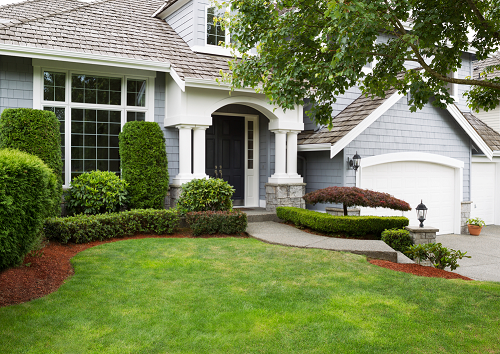
1: Combining Tulips with Perennials and Annuals
Combining tulips with perennials and annuals creates a harmonious arrangement that comes back each year with little maintenance. Just space out your flowers to ensure that the tulips stand taller than the shorter, low-growing perennials and annuals. Typically, your tulips will return every year when winters are colder. There are multiple color choices to pick from, including white and black tulips. Overall, planting clear, primary tulips creates a festive effect in any mixed flower bed. Some companion options for a full flower bed include Daylily, Catnip, Bells of Ireland, and Salvia.
2: Side Yard Flower Bed for Tiny Spaces
You can leverage your sidewalk by planting pretty bizzy lizzies in a beautiful flower box and around the edge of a foundation bed. To bring out an inviting look, contrast their pink and white blossoms with deep green hosta lilies. Although hosta lilies are commonly planted for their foliage, they also bear tiny white, lavender, or violet flowers.
3: Reconditioned Tree Stump Flower Bed
If you have old tree stumps within your yard, why not use them for a flower bed instead of digging them out? Add a pelargonium in the center and surround it with deep purple bellflowers and gold and orange nasturtium with variegated leaves. Additionally, plant some bellflowers, ornamental grass, and pelargonium around the roots for an excellent balance.
4: Rustic Hollow Log Flower Bed Idea
A hollow log can make a perfect flower bed for your home. Simply shovel in some gardening soil and plant some cheerful flowers such as pink, white, and blue phlox, daffodils, red gerbera, and blue irises. The green sword-shaped leaves of these flowers will contrast with the softness and brightness of your blooms, creating an inviting flower bed.
5: Tile Deck with Built-In Flower Beds
If you plan to add a patio or deck to your home, consider one with built-in planters. You can have inbuilt planters made of tile to match your tile deck or opt for a wooden planter. Built-in flower beds can transform your deck into a delightful living space, especially if you plant eye-catching flowers such as pure white roses contrasted with butter yellow sundrops and purple lavender.
6: Raised Block Flower Bed
You can make a raised bed using pre-cut blocks and pavers to make tending easier, particularly for the elderly. Consider planting ornamental grasses, asters, turf lily, small ornamental trees, and chrysanthemums for added beauty. Besides, you can even add herbs or vegetables to your raised block flower bed.
7: Gravel Yard Flower Bed
Having a bed in a gravel yard allows you to indulge in various heights, textures, and colors provided by agave and aloe plants. You could even add ornamental grasses, rosemary plants, sedges. Consider using colored gravel to separate the flower bed from the yard and mulch to brighten the color of your pants.
8: Flower Bed with Clay Pots
Nothing beats clay pots in terms of convenience in organizing and maintaining flower beds. Arrange multiple clay pots half-buried in a raised bed of gravel and plant beautiful bulbs and party-colored tulips. You could also add plants such as daffodils and onions or garlic.
9: Wheelbarrow Planter Flower Bed
If there is an old wheelbarrow lying around in the yard, you could plant it in the middle of your garden and fill it up with bizzy lizzies. You could also create a background of false sunflowers and add more bizzy lizzies and daylilies in front.
10: Vintage Suitcase Flower Planter
You can repurpose an old suitcase to create an exciting flower bed. Simply prop the suitcase on a chair and plant attractive white and purple striped bizzy lizzies, magenta, white asters, or petunias. If you’re worried about filling your old suitcases with dirt, consider planting the flowers in containers first.
11: Antique Bed Frame Flower Bed
Making flower beds out of old furniture is the latest trending flower bed idea. You can have a headboard draped with gold, purple, or white flowers and pillows made of tiny privets. You can then create a mattress with grasses, flax, or violets and crown it up with a footboard made of white-flowered shrubs.
Wrapping Up
If you’re looking to spice up your garden a little bit, these flower bed ideas could be a great way to do it. However, you need to remember that it takes some effort, time, and money to give your garden an extra splash. But at the end of the day, you’ll have a refreshing space to enjoy nature at its finest. Contact us for more information.
Small Backyard Ideas for a Magical Outdoor Space
Well-designed outdoor spaces can increase your enjoyment of your home. But what if you have a small backyard? Well, the good news is you don’t need a sprawling estate to transform your backyard into an outdoor oasis. Thoughtful landscape design can transform your small patio or yard into a refreshing outdoor space.
Transform Your Home with these Small Backyard Ideas
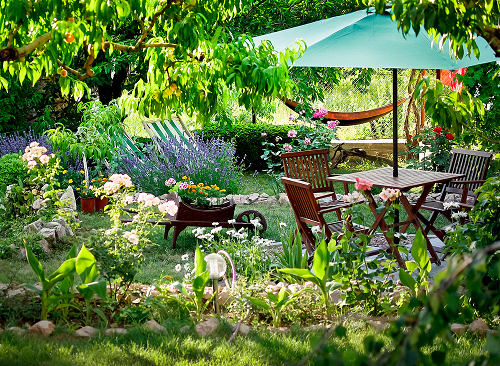
Whether you live in an apartment, townhouse loft, or a house with minimal outdoor space, you can carve out an outdoor space for yourself. Yes, even modest balconies and rooftop terraces count. Even a small yard can feel grand if you design it the right way.
Here are some small backyard ideas that can help you maximize the little space you have.
1. Create a Container Garden
You may not have the space or time to become a master gardener, but you can learn to create striking container gardens. When you lack good soil, containers allow you to make the ideal conditions for your plants to thrive.
All you need is a planter, some potting soil, and the plants of your choice. From hanging baskets to window boxes, you can embellish your backyard with bold foliage for a refreshing space your friends and family will love.
2. Think About Vertical Space
Vertical gardens, or living walls, are ideal features for small spaces. Think of the magnificent living tapestries that ornament public gardens and some buildings. You can bring the same beauty and vitality into your home using vine-covered trellises, closely planted fruit trees, and decorating your walls with hanging plants.
Reinvigorating your exterior with a living wall brings your backyard to life, attracting songbirds and pollinators, and can help temper the summer heat. Living walls also act as art, establish boundaries within a landscape, give you a sense of privacy, and obscure undesirable views.
3. Create a Focal Point
Focal points are used in landscape design to draw and direct the eye. If your backyard consists of a swath of plants or is crammed with furniture, your eyes will sweep along the area, not knowing where to land.
If your backyard is filled with plants and feels more like a garden, you can use a statue or a small fountain to detract some attention from the plants. You can also strategically place furniture to draw in the eyes. Conversely, if your space is adorned with furniture, you can use a large plant as a focal point.
4. Use Every Inch – Even the Side Yard
The side yard is often overlooked and can easily become a sad spot adorned with nothing but unsightly air-conditioning units. You can perk up your side yard by adding a stepping-stone path or install a welcoming entry gate if your space allows.
Another way is to draw the eyes up, away from the sides, using arbors, hanging vines, or strategic overhead lighting.
5. Embrace a Multi-Level Landscape Design
Breaking up your yard with steps, decks, retaining walls, or terraces can create the illusion of a larger backyard. A multi-level design helps to break things up visually, and you can help you separate the different functionalities of your yard.
You can have a dining patio on the upper level and incorporate different greenery into the lower levels.
6. Create a No-fuss Patio or Deck
Don’t have a green thumb? Not to worry. You can set up a murphy bar or an al fresco dining room on a bed of gravel, and voila! You added a little polish to your backyard. Add some statement chairs to create a laid-back or rustic atmosphere depending on the vibe you’re going for. And don’t forget to add some hanging lights to elevate the mood at night.
The idea here is to create a warm, welcoming space that doesn’t require you to get your hands dirty.
7. A Small Kitchen and Dining Area
Love to grill? You don’t necessarily need a large space for this. You can create an outdoor cooking center. All you need is a little space for a basic grill, counter, and a small dining area. You can even add to the ambiance by adding a fireplace or a small garden.
For your family, this could mean growing herbs in the garden, cooking dinner outdoors on the weekends, and enjoying evenings by the fire.
8. Maximize on Available Space
When you have a small backyard, it’s best to create a multifunctional space. You can invest in some portable furniture that you can keep in your basement or garage when not in use. Or, you can create seating benches that also double as storage spaces for lawn games and plants.
Better yet, you can build a mini storage shed that’s cute yet functional.
Revitalize Your Backyard
Looking for small backyard ideas that make a statement? DK Landscaping can help you create the backyard of your dreams. We are a full-service maintenance company with the tools and expertise to help you create a flourishing landscape.
Contact us today! The solution to your lawn and garden woes lies with us.





